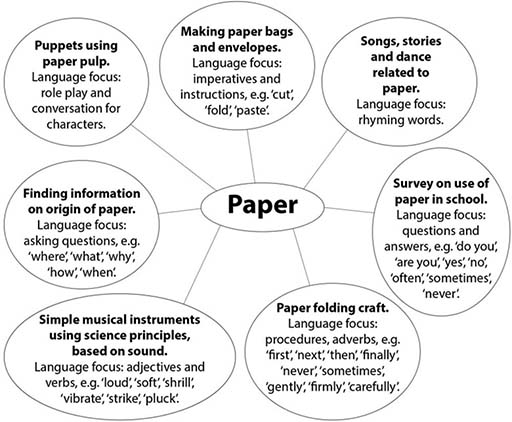2 Using paper as a theme
Activity 1: English in a thematic unit on ‘paper’
Figure 3 shows English-language activities on the theme of paper for middle school students. Note how the teacher has focused on the English-language features within each specific activity.

Looking at Figure 3, identify the following:
- How each activity listed in the diagram relates to a school subject.
- How much time would be needed to do these activities in a large class.
- What resources would be required.
Whether a single teacher can do all these activities, or should it be a collaboration with other subject teachers.
In the next case study, read about how a teacher plans to develop students’ English through an activity that incorporates mathematics and paper craft.
Case Study 2: Mr Bajwa integrates English and mathematics in paper craft
Mr Bajwa teaches Class VII. Note that a flexagon template is available in Resource 1.
In a thematic unit on paper, I was focusing on English language. I consulted with the mathematics and science teachers, and planned a paper craft activity. Students would make a paper geometric shape that could be used to present science information.
I have a large class of 48 students. The English period was just after lunch. I requested four students to come ten minutes early and asked them to help me place a sheet of paper for each student on their desks. One of the students in my class, Savitha, is blind. I had consulted the special educator when she visited our school the previous week. She suggested that I could give Savitha a sheet of sandpaper for this activity.
I gave the instructions in English. I had practised this before the lesson. This is what I said, slowly, step by step, demonstrating as I went:
We are going to make a flexagon today.
I have given each of you a 20 × 10 square centimetre sheet of paper. Now listen to my instructions carefully. I will demonstrate, and I will repeat everything twice. Please listen to the instructions carefully. You may ask for help after I complete my instructions.
Are you all ready? Shall we begin?
First, firmly crease the middle line of the rectangle along the length, and firmly fold the long edges to this midline.
Second, fold to make eight equal segments along the width. You now have eight rectangles – four along the top of the middle line and four along the bottom of this line.
Next, with a pencil, carefully draw diagonals inside each of the rectangles you have folded. Crease them well. Then, bring the paper’s left and right sides together and insert one side inside the other, making a three-dimensional prism.
Next, gently push in the three triangular areas at the top of each other. Then carefully press all the three top points down and through the centre.
Can you see that the next row of triangles makes a similar shape?
Once again, press all three top points down and through the centre.
Finally, turn the model over and gently push in the three triangular areas at the top of each other.
Your flexagon is now ready. You can use this to show a cycle such as the food chain by drawing a different picture on each of its faces. How many of you were able to complete the flexagon? Who needs help?
I was happy to note that, with a little help from her neighbour, Savitha had also completed her flexagon.
Pause for thought Mr Bajwa developed a mathematical activity where students were actively involved in listening to English as they made a resource for learning. He started by establishing rules to ensure classroom management during the activity. He repeated his instructions in different ways. The visual aid of the flexagon reinforced all the language learning.
|
1 One theme, many perspectives
